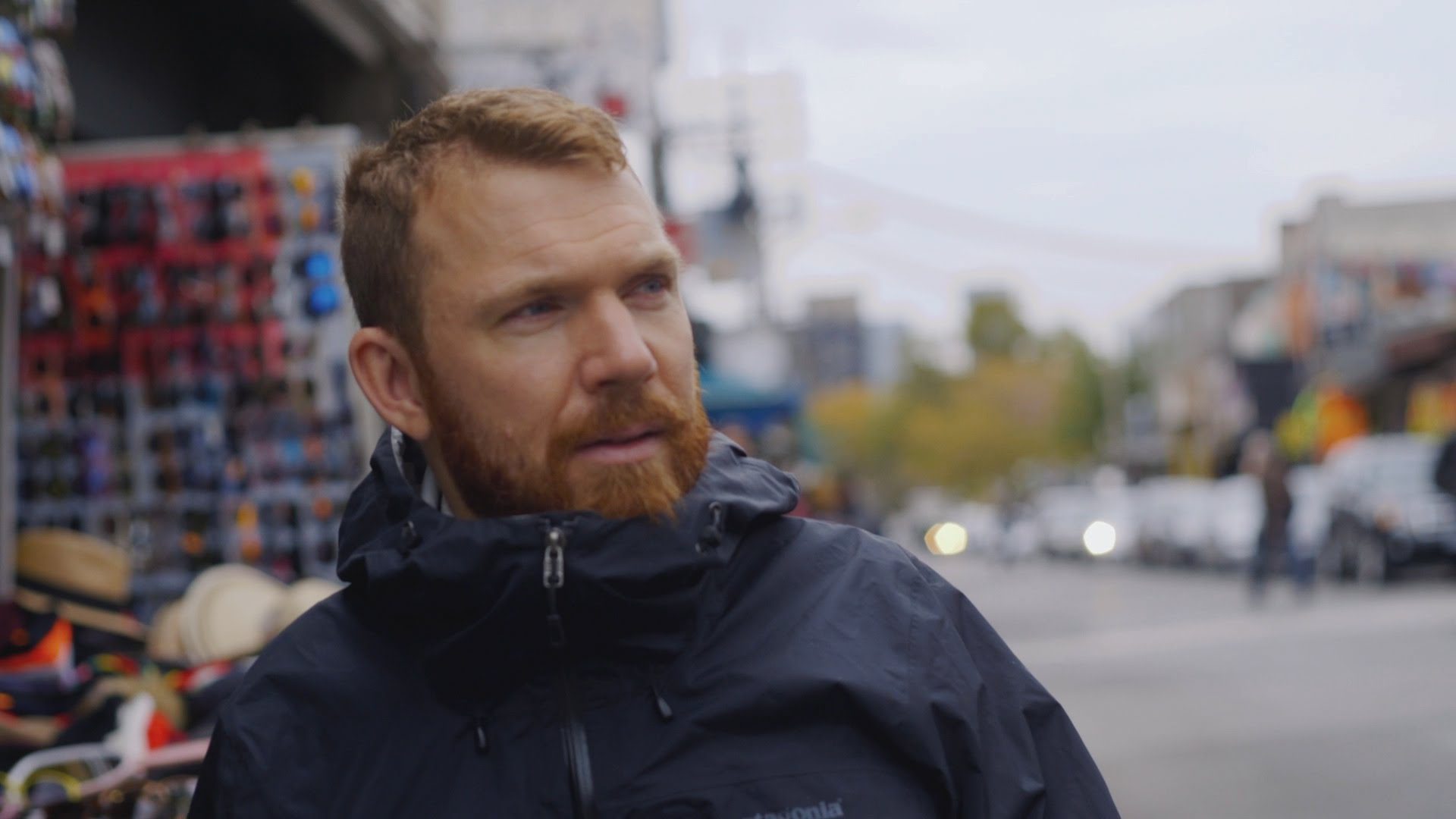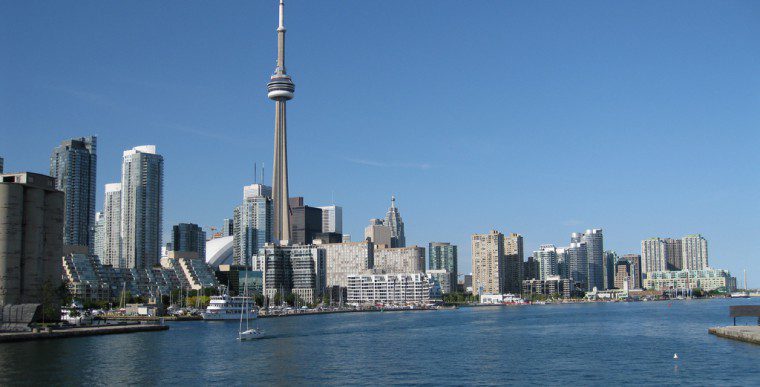The role of an engineer is to solve a problem. And I believe that the work that I’m doing now is helping solve a problem.
On a windy afternoon in the first week of 2017, I sat in the bustling lounge of the Centre For Social Innovation on Spadina Avenue and listened to Luke Anderson talk about some of the problems that he is working hard to solve. Problems such as the steps that lead from the sidewalk into a store, for instance – an architectural feature so ubiquitous that I’d never even thought about them, or noticed them, or wondered how on earth someone in wheelchair deals with them.
Anderson started dealing with them 15 years ago, when an accident left him partially paralyzed and made – by his estimates – almost two-thirds of Toronto off-limits to him. Determined to change this, Anderson started up the StopGap Foundation, a non-profit devoted to installing ramps in Toronto-area businesses. The Foundation – which has grown to include 30 or 40 volunteers – has its office at the CSI at 215 Spadina but is responsible for inspiring the installation of hundreds of ramps across the country.
What is your connection to Toronto?
“I grew up just North of Toronto, and did my undergrad at the University of Waterloo. But a passion for mountain-biking took me to B.C. after I graduated in 2002. A mountain-bike crash caused a spinal cord injury and resulted in a need to come home and be back with close friends and family for my rehabilitation and, just, new life, really. Learning how to navigate my way through a world that’s really not well suited for someone who uses a wheelchair.”
And you weren’t the only person being cut off by this lack of accessibility.
“No, it wasn’t just myself who then wouldn’t be going into a business, it was the friends I was with who would also be barred from shopping there because they wouldn’t bother going in if I couldn’t. I also started to realize that parents pushing strollers, delivery people, elderly, other mobility aid users – they all had an issue with this situation. And nothing was being done about it. The city wasn’t doing anything to alleviate some of these issues. New buildings were being built – and are still being built – with stepped entryways. And I wanted people to start talking about this problem. I wanted people to start thinking about great ideas that could help overcome these issues. And my frustration really reached a tipping point where I needed to figure out a way to get this issue on people’s radar.”
And this frustration turned into the first StopGap ramps in 2011?
“The first project really, I kind of took it on as a side project. I was working full-time as an engineer, and I wanted to experiment with this concept of gifting thirteen business in a neighbourhood with free ramps, just to see what would happen. That’s really where I thought the project would end. I didn’t think that it would stimulate so much interest, and when it did, we realized that there was a real need – from small business owners that were participating, because they responded really well to what we were doing. And community residents responded really well.
The media picked up on our project and wrote stories about it. It all pointed towards doing more of that work. So we moved to different neighbourhoods throughout the city and developed some really great experience on how to effectively implement our project. And then we’d been getting requests from other communities wanting to take on this project as well, so we put all that learning into a document and put together other templates and resources and shared them with those communities.”
[fvplayer src=”https://www.youtube.com/watch?v=5UxUhiFE2Eg” splash=”https://torontoism.com//images/2017/01/a-stop-gap-story.png” width=”780″ height=”586″ caption=”A StopGap Story”]
Can you name some of the Toronto neighbourhoods where you’ve installed ramps?
“The Junction neighbourhood was our very first, Kensington Market was an early one. The Danforth. Mount Pleasant Road was another, The Beaches. College Street, Bloor, Bloor Street West. We’ve been all over the place. Leslieville. The most recent one was maybe Queen West, and, like, East Danforth neighbourhoods.”
How has StopGap grown and changed since it began?
“Well, since 2011 those 13 ramps have expanded into over forty different communities right across the country, with over twelve hundred ramps. People have started up their own version of it. So they take on their own chapter of what we’ve started here. And using our information and our resources, our templates and our consultation they do it all under their own steam. But oftentimes we will hear from business owners on a one-off basis. So business owners will contact us and say ‘Hey, we would love a ramp. We noticed that our neighbours have them, they love them, we want one now too!’ So we’ve developed a Ramps on Request program that allows us to respond to those requests. So we’ll hire a contractor and build a ramp.”

Luke with Lowe’s Canada volunteers
You quit your job two years ago to run Stopgap, and are now its only full-time employee. What does that entail?
“Well, there’s a lot going on. We’ve developed a school program where we visit schools to talk about what we do and invite school groups to be a part of what we’re doing. So kids go out and talk to business owners in their neighbourhood, write letters to them, and those business owners are then in touch with us and we allow the kids to be involved with painting the ramps and delivering them. That’s super exciting. And part of my day involves working on our school program. Part of my day involves coordinating volunteers to help us deliver ramps, paint ramps, build ramps, spread our message far and wide. We have a social media presence that always needs to be updated and populated with information about what we’re doing. We have an active board, so another task is getting our board members to help out with what we’re doing. Fundraising, grant writing, helping us with PR and promotions– that’s just a few things out of many.”
Tell me about some of the other people who make StopGap work.
“My good friend Michael Hopkins helped get the initiative off the ground during the first couple of years doing a number of ramp projects in different neighbourhoods here in Toronto. Michael is now raising a family and therefore has limited free time, but he is still helping out in spirit. A number of friends and my immediate family were also a part of the project during its infancy and continue to help out on a volunteer basis whenever there is a need. Then there’s our core group of volunteers who are always around to help out. We’ve had some great corporate support. Corporate groups have been helpful by giving donations and further involvement where they come into our workshop and help paint ramps as part of a team-building exercise. Much like a Habitat for Humanity model they benefit from that experience and so do we.”
The first StopGap ramps were temporary. Have they been replaced something permanent?
“All of our ramps are removable. They’re all temporary, light-weight, and they’re to be used on a request basis, so they’re not to be left on the sidewalk full-time because they violate current building code and bylaw. Encroachment bylaw. And we have a waiver that outlines how they should be used. Business owners who participate take on any risk or liability. They take on the responsible use of the ramp. We’ve developed a sign that business owners can put in their window to let people know that they do have a ramp available. But generally what we’ve found is most businesses tend to leave them out. But they’re taking matters into their own hands when they do so.”
The request-basis system seems very inconvenient for both business owners and potential customers, but a restaurant did get into legal difficulty a few years ago because they left their ramp out all the time. How would you like to see this resolved?
“The idea of permanency is an ultimate goal of ours. The name StopGap is strategic; it’s not a perfect solution. We hope that one day we won’t have to see these ramps or build these ramps because when a municipality re-does their sidewalks, for example, they might raise the elevation of the sidewalk to meet the height of the steps. But we have to start somewhere, and this is where we need to start; just with getting people aware of the issue. Not only that but posing a possible solution.”
Are there any more accessibility-minded places that Toronto could learn from?
“Yeah, yeah, for sure. I’d say the Scandinavians have it pretty good because they design with everybody in mind. And that’s the type of design methodology that we need to start adopting. So I think countries like Sweden, cities like Stockholm – where I’ve visited, so I experienced first hand how incredible that is, to be able to – in most cases – navigate independently throughout a city like that.”
Besides stairs, what are some of the other major barriers to accessibility in Toronto?
“Well there’s physical barriers, right? Our transit system is horrendous. There are doorways that are problematic for people who can’t manage a fob system of door opening. The list goes on and on. But beyond the physical barriers, we commonly use language that doesn’t put the person first. So whenever we refer to someone with a disability we should be putting the person before whatever disability they have. So ‘a person with hearing loss’ or ‘a person with vision loss’ is a more empowering way to refer to someone in that situation.”
[fvplayer src=”https://www.youtube.com/watch?v=QBp5RVScxI0″ splash=”https://torontoism.com//images/2017/01/luke-anderson1.png” width=”780″ height=”586″ caption=”Luke Anderson’s TedTalk”]
You do a fair bit of public speaking now. What’s that like, and when did it start?
“I started doing speaking engagements about a year after sustaining my spinal cord injury. I was incredibly nervous before my first engagement, so nervous that I almost made my stomach upset! I still get nervous, however, I have become much more comfortable in front of an audience and have developed a passion for sharing my story. Regardless of the age group, there’s a similar response that I get when I wheel into an auditorium or a conference room. I see looks of fear and apprehension.
A lot of people haven’t met somebody who uses a wheelchair – they certainly haven’t been part of a presentation like the one that I give. And they’re not sure. There are looks of … I’m looking for the word that describes the look on the face of a kindergarten kid as well as on a bank executive. And it’s.., maybe an ignorance. It’s an ignorance, but as soon as I start telling some stories and cracking some jokes those looks change from looks of fear to real curiosity and interest. So I know I’ve done my job when I see that transition happen.”
You can help too!
- If you’re interested in building a ramp for your business, visit StopGaps website here and contact them with your request.
- If you want to help Luke Anderson and the StopGap Foundation by volunteering, sign up here!
- If you want to donate or become a sponsor of the StopGap Foundation, you can do so here.
JN00SK





